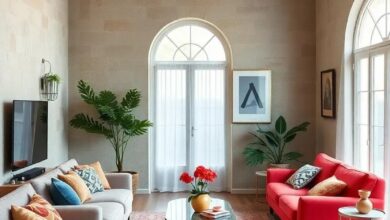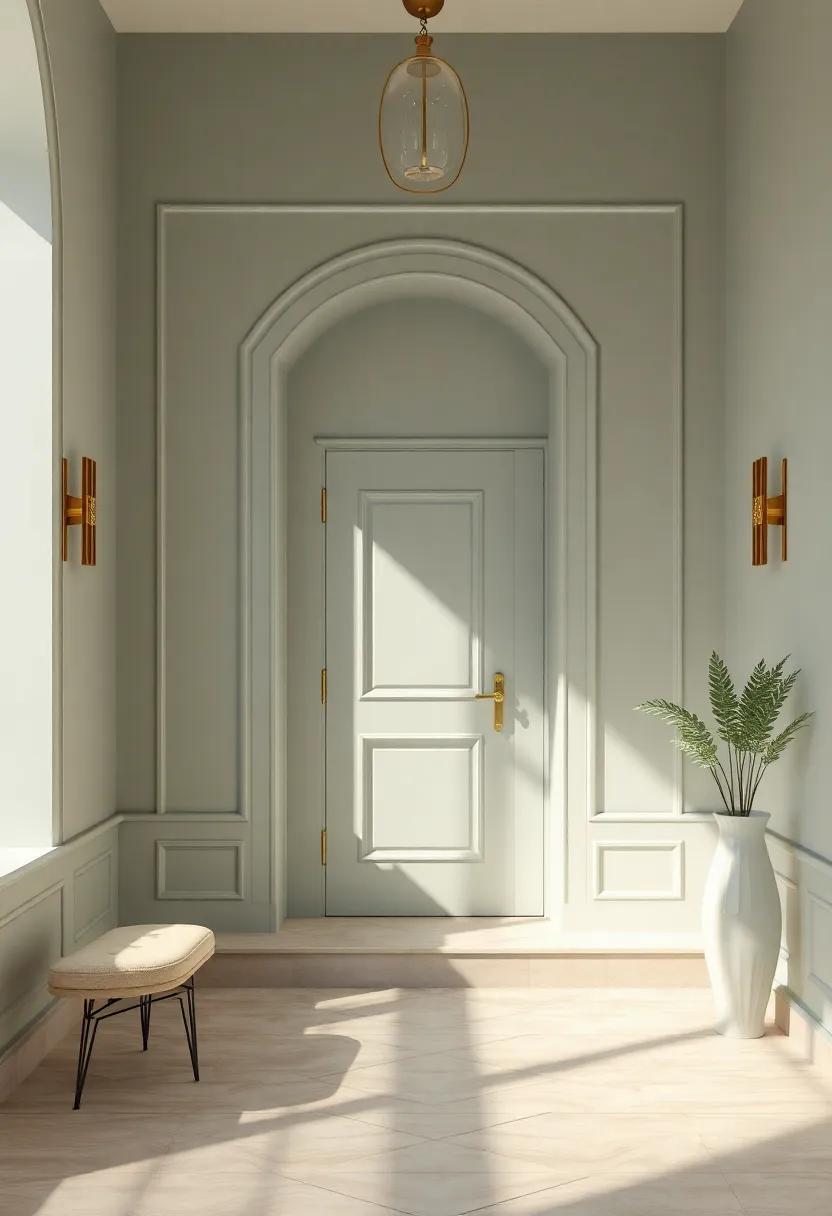
Step Into Elegance: Exploring the Allure of Art Deco Entryway Designs
As we cross the threshold into our homes, the entrance serves not merely as a transition between the external world and our private sanctuary, but as a powerful statement of style and sophistication. Amongst the myriad of design movements that have shaped our interiors, Art Deco stands out with its distinctive blend of elegance and exuberance. Originating in the 1920s and flourishing through the 1930s, this artistic style encapsulates luxury through its bold geometry, opulent materials, and meticulous craftsmanship. In this article, we invite you to step into the enchanting world of Art Deco entryway designs, where each embellished door and meticulously crafted detail reveals a narrative rich in history and glamour. Join us as we explore the captivating elements that define this timeless aesthetic and discover how you can bring a touch of Art Deco charm to your own home.
Step Into Elegance With Grandiose Entrance Features Inspired by Art Deco Designs
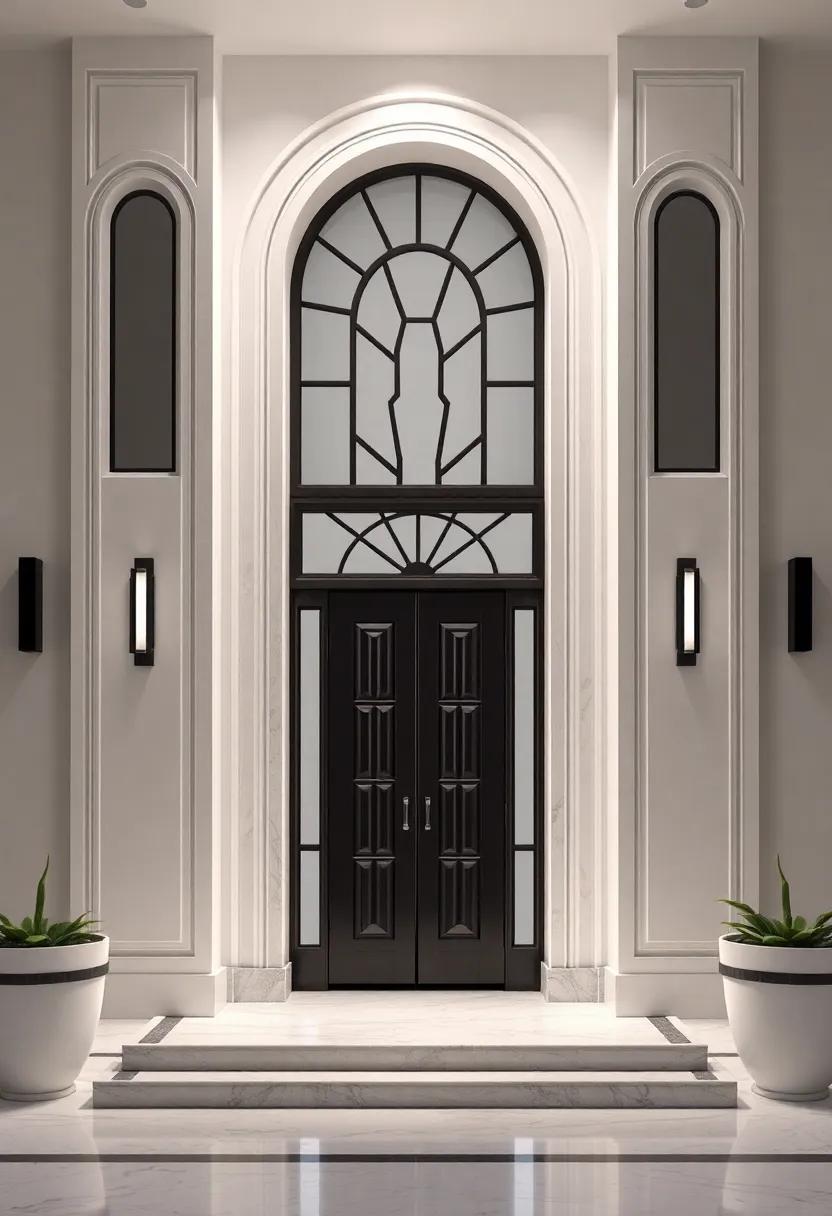
art Deco emerged in the 1920s as a celebration of glamour and innovation, and its distinctive flair continues to captivate contemporary design. the entrance of a home serves as a visual preview of the style within, and incorporating Art Deco elements can create a striking first impression. elements such as bold geometric patterns, rich materials, and intricate detailing come together to evoke a sense of sophistication. Consider integrating features like:
- Stylized doorways: Opt for oversized,ornately carved doors embellished with brass or chrome hardware that highlight the era’s opulence.
- Elegant Lighting: Install fixtures with clean lines and an artful symmetry, utilizing materials such as etched glass or polished metal to radiate warmth.
- Framed Mirrors: Use reflective surfaces in the entrance to amplify light and space, enhancing the luxurious feel.
Beyond mere aesthetics,the functionality of an entrance can also be enhanced with Art Deco inspiration. The design principles emphasize balance and harmony,encouraging a layout that flows seamlessly between the indoor and outdoor spaces. By incorporating elements like:
| Feature | Benefit |
|---|---|
| Marble Flooring | Timeless elegance and easy maintenance |
| Faux finishes | Cost-effective luxury for walls and ceilings |
| Architectural Moldings | Adds dimension and character to the space |
Each feature not only serves to enhance visual appeal but also uplifts the spirit of the space, inviting you and your guests to embrace the grandeur of a bygone era. By incorporating these thoughtful design aspects, your entrance can transform into a hallmarked statement of elegance.
Art Deco Color Palettes: Captivating Combinations for a Timeless Entryway

The Art Deco movement is renowned for its striking geometric shapes and luxurious materials, and its color palettes are no exception. When designing an entryway that reflects this timeless style, consider combinations that evoke opulence and sophistication. Rich jewel tones paired with metallic accents can create a breathtaking first impression. For instance, deep emerald greens, vibrant blues, and sumptuous purples can be beautifully complemented by gold or silver finishes. This contrast not only enhances depth but also adds a dynamic quality that welcomes guests into your home.
To achieve a contemporary interpretation of Art Deco aesthetics, playful yet elegant color schemes can be employed. Consider the following combinations to inspire your entryway design:
- Midnight Blue and Brushed Gold
- Emerald Green and Crystal White
- Deep Burgundy and Champagne
- Charcoal Gray and Rose Gold
| Color Pair | Emotion Evoked |
|---|---|
| Midnight Blue & Brushed Gold | Elegance |
| Emerald Green & Crystal White | Freshness |
| Deep Burgundy & Champagne | Warmth |
| Charcoal Gray & Rose Gold | Modernity |
The Geometry of Glamour: Exploring Bold Shapes in Art Deco Door Frames

The Art Deco movement is characterized by its striking combination of geometric patterns and bold shapes that punctuate the design of the era. When it comes to door frames, this translates into an exquisite manifestation of elegance and sophistication. the use of sharp angles and stylized curves creates an inviting portal that not only serves a functional purpose but also stands as a statement piece of architectural art. Think of the zigzag motifs, sunburst patterns, and streamlined forms that frame these entrances, reflecting the spirit of innovation and luxury that defined the age. Each entryway becomes a canvas, showcasing the potent blend of artistry and craftsmanship that beckons observers to step inside.
The allure of these unique shapes lies not just in their appearance but in their capacity to transform the ambiance of a space. Architectural elements like fluted columns,crowned arches,and shadow boxes add distinctive character and flair,drawing the eye and engaging the imagination.By employing a palette of deep, rich colors alongside shiny metallic accents, these door frames create a visual dialog between the interior and exterior worlds. To better illustrate the enchanting details that can be found in customary Art Deco door frames, consider the following table showcasing various design elements:
| Design Element | Description |
|---|---|
| Chevron Patterns | Elegant zigzag lines that signify movement and dynamism. |
| Curvilinear Forms | Smooth,rounded edges that soften the harshness of geometric shapes. |
| Sunburst Design | A radiant motif that symbolizes light and prosperity, often radiating from the centre. |
| Relief Details | Three-dimensional adornments that enhance visual interest and texture. |
Illuminating Elegance: The Role of Lighting in Art Deco Entryway Aesthetics

In the world of Art Deco, lighting serves as more than just a practical necessity; it becomes a crucial element that enhances the overall aesthetic of entryway designs.The interplay of light and shadow creates a dynamic atmosphere, allowing luxurious materials and intricate patterns to reveal their full glory. Stunning fixtures made of polished metals, colored glass, or even crystal radiate opulence, transforming mundane spaces into captivating portals of elegance. Consider the following characteristics of effective Art Deco lighting:
- Geometric Shapes: Fixtures frequently enough exhibit angular, bold lines that echo the architectural style.
- Illumination Layers: A combination of ambient, task, and accent lighting adds depth to the entryway.
- Reflective Surfaces: the use of mirrors and shiny materials amplifies light, enhancing the spatial experience.
Additionally, the placement of lighting is intentionally strategic, guiding the eye and creating focal points that draw attention to ornate details. When paired with rich color palettes—like deep emeralds, vibrant golds, and dramatic blacks—lighting elevates the opulence inherent in Art Deco design. A thoughtfully designed entryway might incorporate various lighting sources,from sconces framing the door to a grand chandelier above,ensuring that every angle is perfectly illuminated. Here’s a table summarizing some beautiful Art Deco lighting styles:
| Lighting Style | Features |
|---|---|
| Chandelier | Elaborate form with dangling crystals or glass elements. |
| Sconce | Wall-mounted fixtures that complement architectural lines. |
| Table Lamp | Stylish base featuring geometric designs, often in bold colors. |
Materials of Distinction: Luxurious Choices for Art Deco Entryway Designs

The Art Deco movement is renowned for its opulence and sophistication, elevating entryways into realms of extravagant elegance. When considering materials that define this iconic style, a variety of rich and sumptuous options emerge, each contributing to the overall allure of the design. Marble, with its luxurious veins and polished finish, creates an immediate sense of grandeur.Polished metals like brass and chrome add a touch of shine, reflecting light and enhancing the space’s overall brightness. Walnut wood, often intricately carved, introduces warmth and depth, while glass—elegant and clear or frosted and etched—offers a wondrous play of transparency and light.
To fully embrace the Art Deco aesthetic, one might explore an exquisite palette of materials that can be combined for a cohesive look. Consider these captivating choices:
- exotic woods: Mahogany and ebony provide rich contrast and luxurious texture.
- Fabrics: Silk or velvet accents in deep jewel tones, complemented by metallic embroidery.
- Tile: Geometric patterns in glazed ceramic or mosaic form, perfect for flooring or wall features.
- Mirrored surfaces: Adding dimension and a sense of space, reflecting the glamor of the era.
Whether opting for bold contrasts or harmonious blends,these materials serve to encapsulate the spirit of Art Deco,greeting guests with an entry that echoes the vibrant elegance of the 1920s.
Art Deco door knockers: Statement Pieces That Define Your Entrance

Art Deco door knockers transform a simple entrance into a grand declaration of style and sophistication. characterized by geometric patterns and vivid materials, these knockers serve as the perfect accent to a beautifully designed entryway. They often feature bold shapes such as chevrons and zigzags, crafted from materials like polished brass, chrome, or even glass. Here are some standout characteristics of Art Deco door knockers that make them a sought-after choice for homeowners:
- Artistic Form: The fusion of function and art creates unique designs that captivate the eye.
- Bold Colors: Use of vibrant hues alongside metallic finishes adds an upscale touch.
- Intricate Details: engravings and embellishments display fine craftsmanship.
The presence of an Art Deco door knocker not only elevates the aesthetic of your entrance but also tells a story of the architectural era that valued opulence and creativity.Imagine the statement it makes—a merging of history and modern-day elegance. With the variety available in styles and finishes, selecting the perfect knocker can enhance the allure of your home’s facade. Consider these popular styles as you seek the ideal match for your door:
| Style | Description |
|---|---|
| Geometric | Features sharp angles and lines, emphasizing symmetry. |
| Figural | Incorporates human or animal motifs,adding a whimsical touch. |
| Circular | Emphasizes curves and form, often paired with intricate backplates. |
Transitional Spaces: The Art of Blending Indoor and outdoor Elegance

The seamless integration of indoor and outdoor elements elevates the overall aesthetic of a home, transforming transitional spaces into captivating extensions of living areas. Natural light pours in through expansive glass doors, blurring the boundaries between the indoors and nature, while geometric patterns characteristic of art Deco highlight sophistication. This fusion creates an alluring atmosphere where sunlight dances off elegant surfaces, enhancing textures such as polished marble and rich woods. to achieve this harmony, consider incorporating features like:
- Translucent dividers that maintain visibility while offering partial separation
- Lush greenery both inside and outside to foster a sense of continuity with nature
- Decorative elements like planters that reflect Art Deco motifs, bridging the two realms
A well-designed entryway serves as the perfect introduction to this chic union. Wide thresholds allow for graceful transitions, while the strategic placement of furnishings like artistic chairs and bold sculptures can make a powerful statement. The use of a color palette that resonates throughout the home, possibly featuring deep jewel tones and sleek metallics, can enhance the aesthetic interplay between the indoors and outdoors. When thoughtfully curated, these design choices lead to a setting that not only invites guests in but also encourages an ongoing dialogue between the spaces, offering an atmosphere of refined elegance.
| Feature | Purpose |
|---|---|
| Wide Glass Doors | Enhance natural light and views |
| Decorative Planters | Add greenery and continuity |
| Bold Artwork | Bridge aesthetic gaps, emphasize style |
Exquisite Flooring Ideas to Showcase Art Deco style in Your Entryway

To truly embrace the Art Deco aesthetic in your entryway, consider opting for flooring that exudes both luxury and style. Marble tiles are an outstanding choice, showcasing intricate veining patterns that capture attention and create a sense of grandeur. Pair these with contrasting geometric designs in black and white or gold accents to elevate your space further. Polished concrete can also provide a modern twist; colored stains can mimic the opulence of marble while introducing sleek lines characteristic of the era. Integrating area rugs with bold patterns can soften the aesthetic, adding warmth and inviting your guests into a stunning environment.
Another flooring option that resonates with the Art Deco theme is herringbone or chevron wood planks. These patterns not only add visual intrigue but also work harmoniously with luxurious decor elements. To enhance the entryway, consider incorporating inlaid designs or borders that frame your flooring, setting the stage for your unique style. Explore various materials, such as engineered hardwood or distressed finishes, to complement ornate lighting fixtures and rich textiles in your foyer. The key is to select a flooring style that serves as both a foundation and a canvas for your deco-inspired entryway, ensuring that every step into your home is nothing short of an elegant experience.
Textures That Transform: The Power of Fabrics and finishes in Entryways
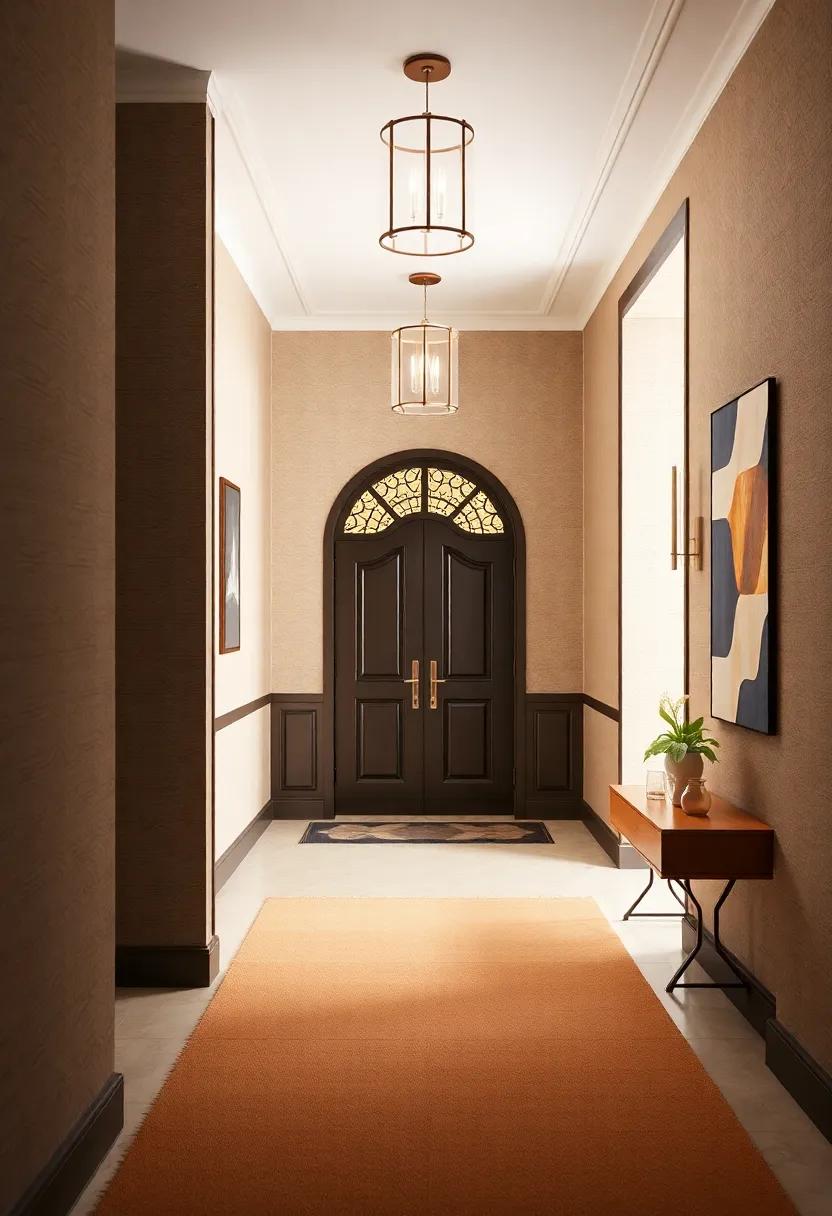
When designing an Art Deco entryway, the choice of fabrics and finishes can dramatically influence the overall aesthetic, creating an inviting atmosphere that radiates elegance. Luxurious velvet, for instance, can transform a simple bench or upholstered chair into a striking focal point. Paired with metallic accents, such as brass or chrome, these textures can create a sense of opulence while maintaining a modern flair. Consider using rich, jewel-toned materials for cushions or wall hangings to evoke the glamour characteristic of the Art Deco period. Some other key elements include:
- High-gloss finishes on furniture or doors to reflect light and enhance the space.
- Textured wallpapers that feature geometric patterns, providing depth and interest.
- Layered rugs, combining different textures such as wool and silk, can add warmth and richness underfoot.
Moreover, the interplay between hard and soft surfaces can further accentuate the design’s visual appeal.A sleek marble entrance can be beautifully offset by soft drapery or an elegant area rug, creating a harmonious balance. To exemplify the contrast in materials, consider the following table, wich highlights complementary finishes ideal for Art Deco entryways:
| Material | Finish |
|---|---|
| Glass | Frosted or etched for privacy |
| Wood | Dark stains or lacquered looks |
| Metal | Brushed or polished for shine |
| Textiles | Rich, sumptuous materials |
Architectural Lines: discovering the Signature Symmetry of Art Deco
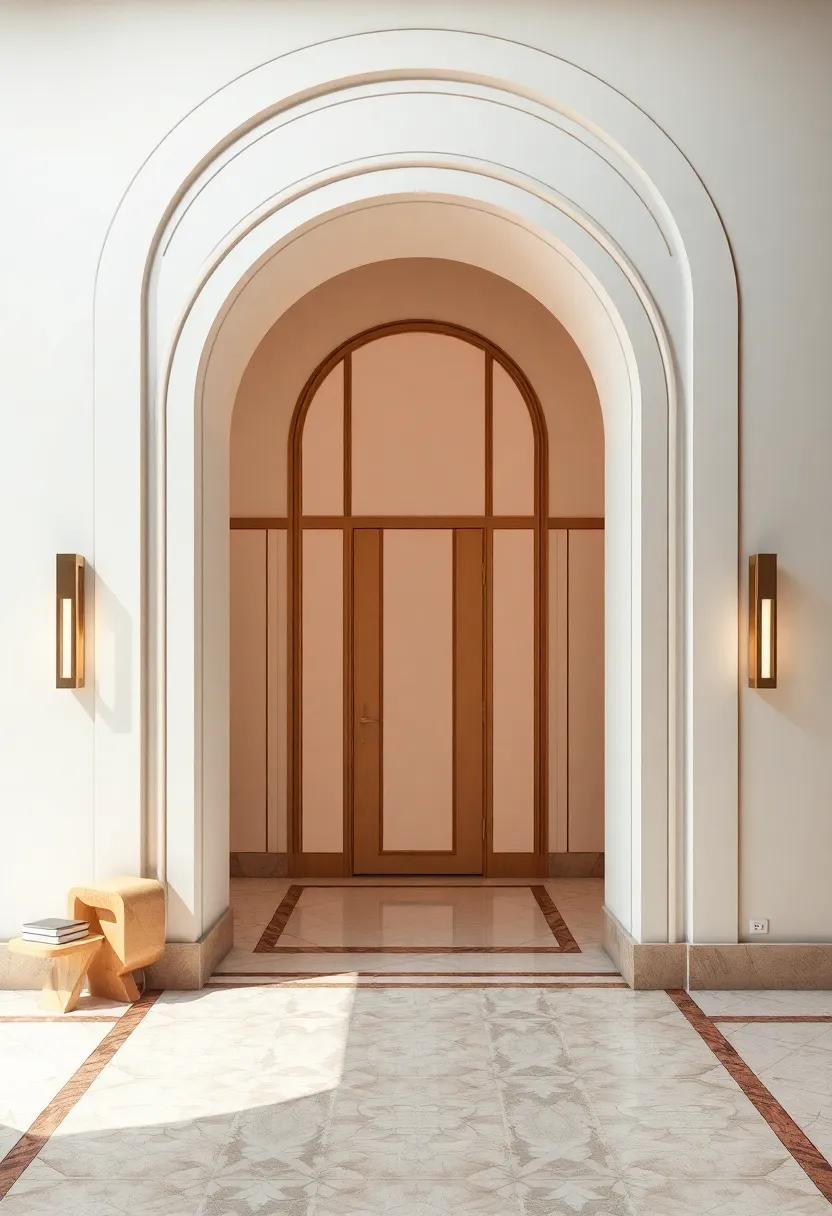
The striking allure of Art Deco entryways can be attributed to their signature symmetry and geometric forms.Characterized by bold lines and lavish ornamentation, these architectural features invite visitors into a world of elegance. Elements such as zigzag patterns, sunburst motifs, and decorative friezes are often intricately designed, creating an inviting threshold that captivates the onlooker.The use of luxurious materials like polished marble, chrome, and glass further enhances the grandeur, making each entryway a statement of personal style and sophistication.
Emphasizing both form and function, Art Deco design encapsulates an era where artistry met innovation. Consider the following hallmarks that define these remarkable entryways:
- Symmetry: Balanced designs that create a harmonious aesthetic.
- Geometric Shapes: Angular details that evoke a sense of order.
- Luxurious Materials: Use of rich textures such as velvet and polished metals.
- Ornamental Features: Sculptural elements that add character and depth.
| Feature | Description |
|---|---|
| Friezes | Decorative bands featuring intricate designs, frequently enough depicting natural themes. |
| Door Hardware | Stylized handles and locks that reflect the geometric aesthetic. |
| Lighting | Bold light fixtures that serve as both illumination and decoration. |
Decorative Moldings and Trim: Adding Character to Entryway Design

One of the hallmarks of Art Deco design is the use of elegant moldings and trim that add depth and sophistication to entryways. These architectural features can transform a simple passage into a striking first impression, showcasing the ambition of the era. With clean lines and geometric shapes, moldings can emphasize the height of a space, while intricate trim work draws the eye toward stunning doorways or windows. adding a touch of metallic paint or gloss finish can further elevate these details, reflecting the opulence characteristic of the Art Deco period.
When considering moldings and trim for your entryway,focus on varied textures and heights to create visual interest.Here are a few options to consider:
- Crown Molding: Adds a luxurious feel by capping walls and ceilings.
- Baseboards: Sleek or embellished baseboards can ground the space and complement flooring choices.
- Dental Molding: A decorative crown or frieze molding that introduces an era-specific flair.
- Chair Rails: Breaks up wall surfaces and can be used to introduce two-tone paint styles.
Creating a Gallery Feel: Showcasing Art in an Art Deco Inspired Entry

To truly capture the essence of Art deco in your entryway, think beyond mere decoration—consider creating an immersive gallery experience. Start by framing your art with bold geometric designs that resonate with the period. Use wide, streamlined frames in finishes like gold or chrome to accentuate the artwork. Incorporate key elements such as:
- Mirrored accents: They reflect light and enhance the feeling of space,creating a dynamic visual effect.
- Stylized sculptures: Select pieces with elegant lines and forms to serve as conversation starters.
- Layered lighting: Install sconces and chandeliers that embody Art Deco aesthetics, allowing your art to shine at different times of the day.
Complement the artwork with a carefully curated color palette that highlights the opulence of the era. Consider using rich jewel tones alongside metallics, such as deep blues, emerald greens, and shiny golds. To further elevate this gallery-inspired ambience, incorporate a stylish display table featuring a selection of art books or small artifacts that invite guests to linger. Here’s a quick overview of elements that might enhance your gallery feel:
| Element | Description |
|---|---|
| Art Selection | Choose bold,graphic pieces that encapsulate the spirit of the Art Deco movement. |
| Framing Details | Opt for thick, luxurious frames that add depth and grandeur to each artwork. |
| Lighting Choices | Use layered lighting to create dramatic contrasts and highlight specific pieces. |
Balancing Functionality and Form: Essentials for a Stylish Entryway
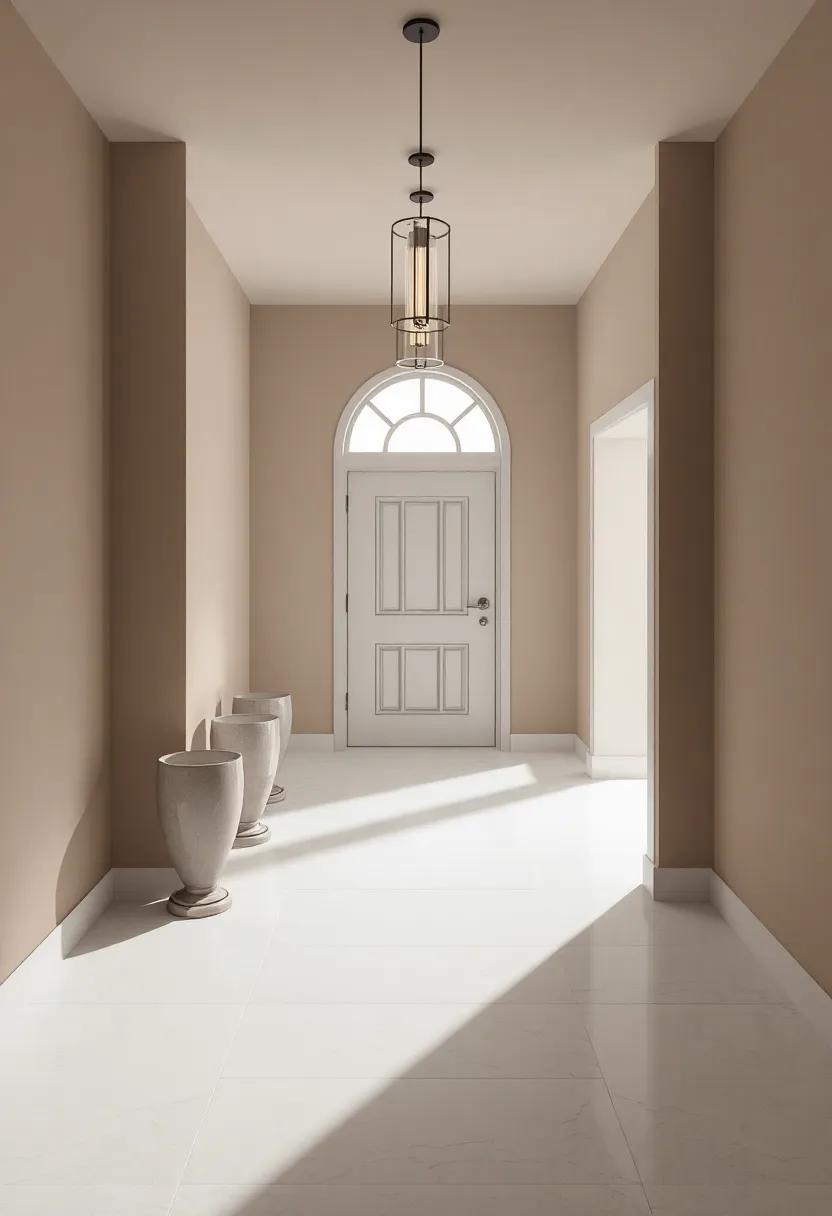
Creating an inviting entryway requires a careful blend of aesthetics and practicality. To achieve this balance, consider incorporating elements that not only catch the eye but serve specific purposes as well. A statement console table, for instance, can act as a decorative accent while offering a place to set down keys or mail. Accessories like a decorative mirror not only enhance the visual space by reflecting light but also provide a convenient grooming spot for last-minute adjustments before heading out. Cleverly chosen finishes and materials, such as a sleek metal frame paired with rich wood, can amplify the Art Deco flair while ensuring durability.
Moreover, incorporating a few key items can elevate the functionality of the space without compromising elegance. Consider the following essentials:
- Stylish Lighting: A beautiful chandelier or a pair of wall sconces can cast a warm glow, welcoming guests into your home.
- Shoe Storage: An elegant bench with hidden compartments can serve dual purposes, providing seating and storage for shoes.
- Artwork or Decorative accents: Select pieces that evoke the glamour of the Art Deco era to reinforce the theme without overcrowding the space.
Revival of Patterns: The Influence of Geometric Designs in art Deco entryways

In the realm of Art Deco architecture, the revival of geometric patterns marked a bold reimagining of space that transcended mere functionality.Entryways, frequently enough viewed as transitional spaces, became lavish expressions of design where angles and shapes took center stage. Notable for their symmetrical forms, repeating motifs, and striking contrasts, these designs invited onlookers to step into a curated experience of sophistication.From zigzag patterns to chevrons, the striking dualities of linear and curved elements provided a visual balance, imbuing entryways with an air of dynamism and movement.
Key elements that define the geometric aesthetic in Art Deco entryways include:
- Bold Colors: Rich hues paired with metallics create an opulent atmosphere.
- Textured Materials: Incorporation of marble, glass, and chrome enhances the richness of the design.
- Stylized Ornamentation: Decorative details, such as reliefs and bas-reliefs, add depth and interest.
When these patterns are combined, they not only frame the threshold to a home or establishment but also narrate a story of luxury and innovation. In this vibrant dialogue between structure and artistry, geometric designs breathe life into entryways, establishing them as gateways not just to space but to a time when elegance was paramount.
Accessorizing with Art Deco Flair: Aligning Décor with Architectural Style

Transforming your entryway into a stunning expression of Art Deco style is all about selecting the right accessories that resonate with the era’s distinctive aesthetic. sleek lines, geometric patterns, and bold colors define this movement, making it essential to choose accents that complement these features. Consider incorporating items such as:
- Vintage mirrors with intricate frames to add depth and reflect light.
- Stylish lighting fixtures, like pendant lights with chrome finishes, that bring a sense of drama.
- Geometric area rugs that anchor the space while showcasing the era’s signature motifs.
- Art Deco-inspired sculptures or vases that serve as statement pieces, infusing character into your decor.
Combining these elements creates a cohesive look that honors the elegance of the Art Deco period. It’s crucial to balance ornamentation with function, ensuring that each piece not only enhances the aesthetic but also contributes to the overall flow of the entryway. Utilizing a variety of materials can elevate the space; consider a mix of glass, metal, and ceramics to reflect the boldness inherent in Art Deco design. For an added touch of sophistication, a well-arranged gallery wall featuring vintage artwork can serve as a captivating focal point, creating an inviting atmosphere that draws guests into your home.
Gardens and Pathways: Setting the stage for an art Deco Entrance
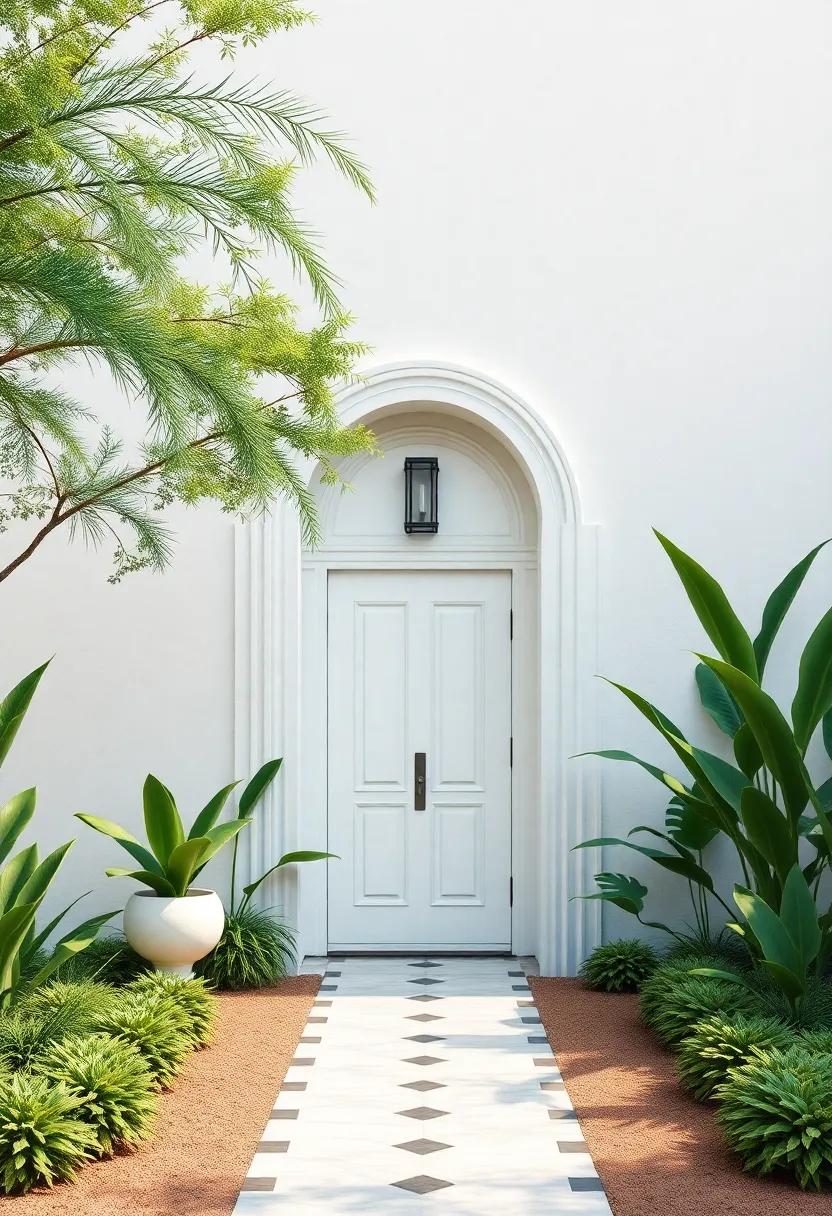
The journey to an exquisite Art Deco entryway begins long before one reaches the door itself.envision a landscape filled with meticulously manicured gardens, where bold geometric patterns and vibrant colors set a captivating backdrop. Consider incorporating:
- Symmetrical flower beds: Arrange vibrant blooms in artistic shapes that mirror the architectural lines of your entrance.
- Striking pathways: Use contrasting materials like polished stone or mosaic tiles to guide the eye toward the door.
- Decorative elements: Introduce sculptures or ornate planters that echo the glamour of the Art Deco style.
effective lighting plays a pivotal role in enhancing the atmosphere. As dusk falls, strategically placed fixtures can illuminate both the pathways and the gardens, casting intriguing shadows reminiscent of the era. Incorporate features such as:
- Artistic lanterns: Opt for fixtures with geometric designs that reflect the unique characteristics of Art Deco.
- Soft landscape lighting: Highlight pathways to create a welcoming ambiance that invites guests to explore further.
- Accent uplights: Position them to showcase key focal points like statues or unusual trees, adding a dramatic flair.
Each Detail Matters: Crafting an Impressive First Impression with Art deco

In the world of Art Deco, every element—from lighting to decorative motifs—contributes to the overall aesthetic and experience of a space. An elegant entryway goes beyond merely being a passage; it’s a statement of your home’s character. Key features that can elevate your entryway include:
- Geometric Patterns: Incorporating bold, symmetrical designs brings a sense of visual rhythm.
- Metals and Mirrors: Use polished metals and mirrored surfaces to create allure and depth.
- Rich Colors: Deep hues with vibrant accents can establish a luxurious atmosphere.
- Statement Lighting: A striking chandelier can serve as the focal point, lighting the way while reflecting the style of the era.
Another aspect of Art Deco entryway design is the use of texture to create an engaging environment. Combining materials like marble, glass, and wood can transform a simple entry into a complex experience. Consider the following elements to enrich your design:
| Element | Description |
|---|---|
| Textiles | Include rich fabrics for curtains or upholstery that add warmth. |
| Artwork | Create visual interest with art that reflects the stylized motifs of Art Deco. |
| Furniture | Choose pieces that exhibit sleek lines and bold shapes, reinforcing the style. |
Historic Influences on Modern Art Deco entries: A Timeless Connection

The evolution of Art Deco design can be traced back to a rich tapestry of historic influences, weaving together aspects from various artistic movements and cultural shifts. The Geometric shapes and bold colors characteristic of Art Deco were inspired by the clean lines of the modernist movement,as well as the elaborate ornamentation of the earlier Arts and Crafts and Art Nouveau styles. This unique blend of tradition and modernity birthed entrance designs that exude a sophisticated elegance, showcasing intricate detailing and a sense of grandiosity. Iconic materials such as chrome, glass, and marble became staples of entryway aesthetics, symbolizing luxury and progress during the interwar period, when design first captivated the masses and embraced a forward-thinking ethos.
Further enriching the Art Deco narrative are the influences from various global cultures, which have left an indelible stamp on contemporary designs. The rise of Egyptomania in the early 20th century, propelled by the finding of Tutankhamun’s tomb, introduced motifs like hieroglyphics and sphinxes into entryway embellishments.Similarly, Mayan and Aztec influences expressed in sculptures and murals can still be seen in certain modern interpretations of Art Deco architecture. These diverse elements come together to create an awe-inspiring visual language, where every entryway serves as a portal not just to a home but to a dialogue between the past and the future.
| Influence | Meaning |
|---|---|
| Modernism | Influenced geometric shapes and functionality |
| Arts & Crafts | Emphasized craftsmanship and detail |
| Egyptomania | Introduced exotic motifs and luxurious elements |
| Cultural Fusion | Enhanced diversity in design elements |
The Allure of Glass: Incorporating Art Deco Windows for Stunning Light Play
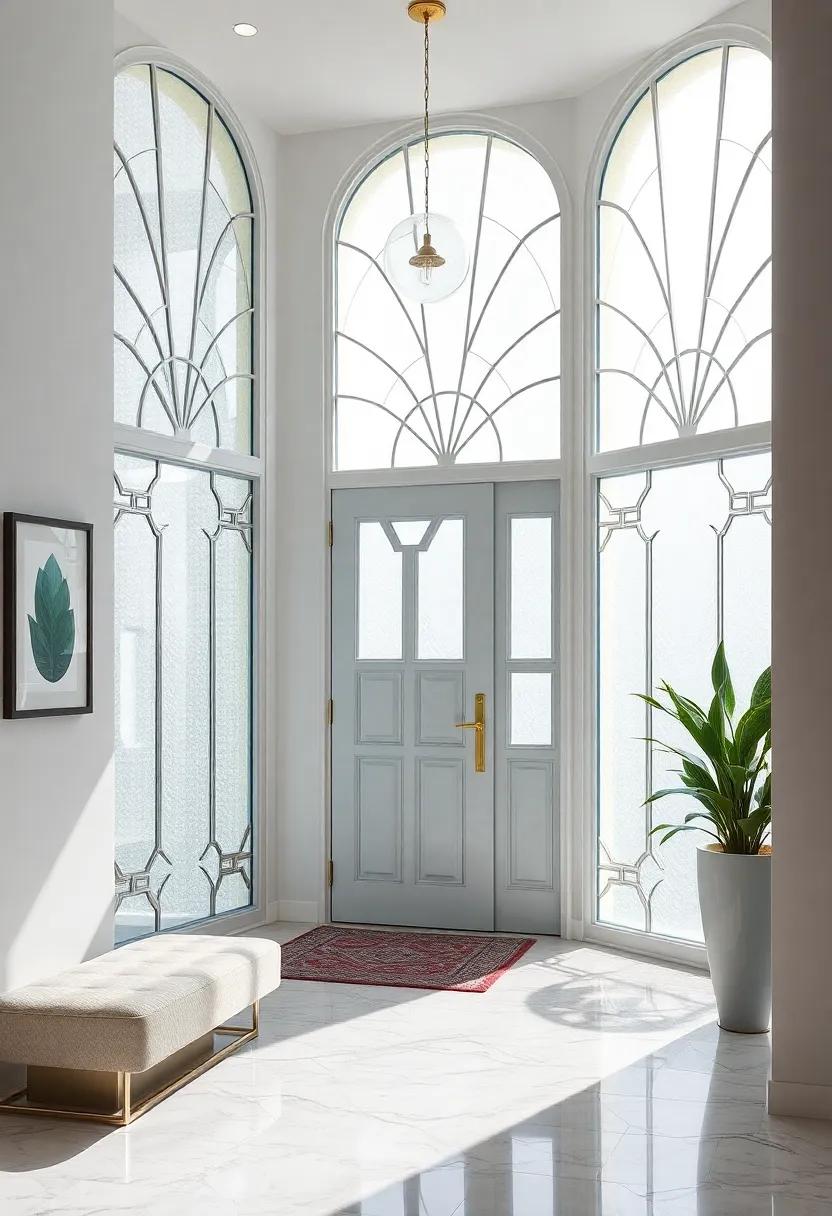
The enchanting beauty of Art Deco windows defies time, drawing us into a world where light dances playfully through meticulously crafted glass.These windows,characterized by their geometric patterns and vibrant hues,serve not only as functional elements of a home but also as mesmerizing art pieces. Their ability to refract sunlight creates a kaleidoscopic effect that shifts throughout the day, enhancing any space with an ever-changing palette of colors. When strategically placed in entryways, they invite natural light to permeate, brightening interiors while offering an artistic flourish that captures the essence of a bygone era.
Incorporating these stunning glass designs into your entryway allows you to pair luxury with light. Consider the various forms they take—frosted glass, stained glass, and etched glass—each adding a unique character to your home. A table summarizing key features can help distinguish their distinctive qualities:
| Glass Type | Characteristics | Ideal use |
|---|---|---|
| Frosted glass | Softens light, offers privacy | Bathrooms, bedrooms |
| Stained Glass | Colorful, ornate designs | Entryways, churches |
| Etched Glass | Adds texture, subtle elegance | modern homes, offices |
Color Accent Walls: Dramatic Statements in Art Deco Inspired Entrances
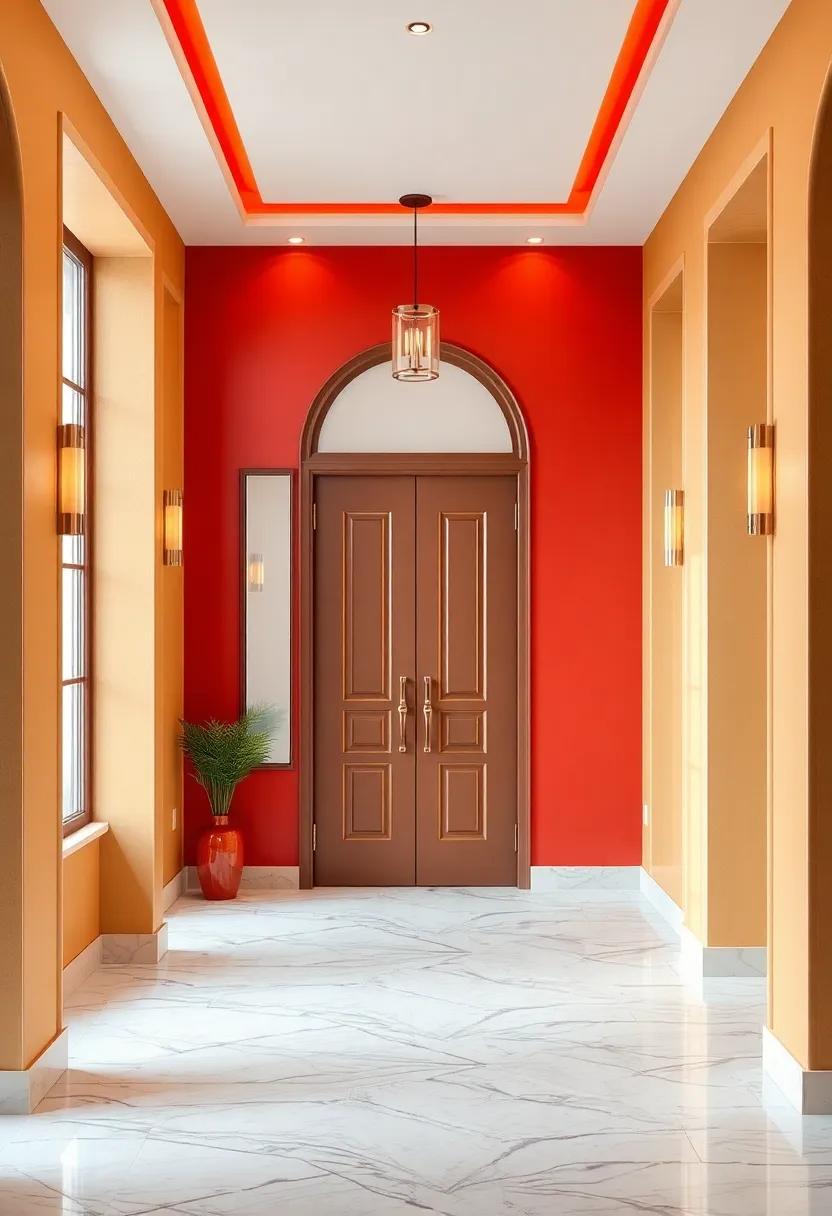
Incorporating a color accent wall into an Art Deco-inspired entrance transforms the space into a bold declaration of style and sophistication.With its origins in the vibrant and opulent design movements of the 1920s and 30s, an accent wall can evoke the glamour of this iconic era. Choosing the right hue is essential; dramatic shades such as deep navy,emerald green,or rich burgundy serve as stunning backdrops that highlight the striking geometric patterns frequently enough found in Art Deco design. Paired with luxurious materials—like polished metallics and exotic woods—these colors create a captivating visual interplay befitting the grandeur of an entryway.
For optimal effect, consider these essential elements when designing your accent wall:
- contrasting Textures: Combine matte finishes with glossy accents to add depth.
- Statement Lighting: Install fixtures that enhance the wall’s color and create dynamic shadows.
- artistic Touches: Incorporate bold artwork or mirrors with intricate frames to reflect the unique character of the space.
| Color Options | Mood & Atmosphere |
|---|---|
| Deep Navy | Calming & Elegant |
| Emerald Green | Luxurious & Inviting |
| Rich Burgundy | Warm & dramatic |
The strategic placement of such a wall not only draws the eye but also enhances the overall aesthetic, beckoning guests to step inside. By carefully selecting colors and complementary design elements, an Art Deco entryway can become a stunning focal point that boasts sophistication and sets the tone for the entire home.
Sculptural Elements: Adding Three-Dimensional Interest to Your Entryway

Incorporating sculptural elements into your entryway can transform it from a mere passageway into a captivating focal point. Consider statues, relief panels, or three-dimensional art pieces that embody the geometric forms typical of the Art Deco style. These sculptural pieces add depth and intrigue, enticing visitors to explore further.When selecting your elements, think about materials that reflect the elegance of the era, such as polished stone, bronze, or glass.Combining various materials can also enhance the visual interest, creating a dynamic interplay of light and shadow as you move through the space.
To maximize the impact of your chosen sculptures, think about their placement within the entryway. Here are some key factors to consider:
- Height Variations: Utilize varying heights to create a layered look, placing taller sculptures on pedestals while keeping smaller pieces at eye level.
- Framing Views: Position sculptures to guide the eye towards other architectural features, like doors or windows, enhancing the overall flow of the space.
- Lighting: Use spotlights or ambient lighting to emphasize sculptural details and cast dramatic shadows that further enrich the entryway’s atmosphere.
Below is a simple table highlighting different types of sculptural elements that work beautifully in an Art Deco entryway:
| Type | Material | Style Example |
|---|---|---|
| Statue | Bronze | Art Deco Figure |
| Relief panel | Wood | Geometric Patterns |
| Wall Sculpture | Glass | Abstract Design |
Timeless Furnishings: Selecting Furniture That Complements Art deco design

When choosing furnishings that harmonize with the glamorous aesthetic of Art Deco, consider pieces that capture the essence of the era through intricate details and bold shapes. Look for furniture crafted from rich materials, such as polished woods, shiny metals, and luxurious fabrics, which reflect the opulence of Art Deco design. Incorporating geometric patterns or motifs will not only enhance the overall style but also create a cohesive look that feels effortlessly elegant. Focus on items that exemplify the era’s signature aesthetics:
- Streamlined forms: Opt for furniture with clean, symmetrical lines.
- Vibrant colors: Deep, saturated hues can add depth and vibrancy.
- Mirrored finishes: Incorporate reflective surfaces to amplify natural light.
In addition to aesthetic appeal, comfort should not be overlooked. Select seating that invites relaxation while also being visually striking. Consider a balance between form and function; as an example, plush sofas adorned with geometric pillows or elegant side tables with bold lines can tie the room together beautifully. When accessorizing, remember that Art Deco thrives on a blend of glamour and artistry, making it essential to pair your furniture with eye-catching pieces such as:
- Statement lighting: Chandeliers or sconces that showcase geometric designs.
- Artwork: Framed prints or sculptures that reflect the era’s flair.
Mirrored Surfaces: Reflecting Light and Style in an Entryway Setting

In the realm of Art Deco design, the use of mirrored surfaces transcends mere functionality and becomes an intricate part of the visual narrative. These reflective elements not only multiply light in an entryway but also serve as striking focal points that encapsulate the essence of elegance. When selecting mirrored furnishings or decor, consider incorporating pieces that feature bold geometric patterns or intricate detailing, which can enhance the luxurious feel of the space. Essential choices might include:
- Mirrored console tables - Perfect for displaying art pieces or fresh flowers.
- Wall mirrors – Expanding the sense of space while bouncing light.
- Decorative mirrored trays – Offering a touch of glam while organizing small items.
Additionally, harmonizing these reflective surfaces with complementary textures and colors can create a cohesive and inviting atmosphere. Pairing mirrors with materials like velvet or polished metals can elevate the overall aesthetic, drawing the eye toward the captivating interplay of light and reflection. A well-curated selection of decor items can bring balance to the design, such as:
| Item | Material | Effect |
|---|---|---|
| Mirrored Candle Holders | Glass and Metal | Soft glow reflecting and expanding light |
| Mirrored Wall Art | Acrylic | Artistic reflection with a modern twist |
| Mirrored Accent Chair | Upholstered Frame | Stylish seating that enhances space |
Embracing nature: Integrating Organic Elements into Art Deco Designs

Art Deco, celebrated for its luxurious and glamorous aesthetics, finds a compelling harmony when organic elements are woven into its classic designs. By introducing natural motifs—such as floral patterns and flowing lines—this architectural style evolves into a refreshing iteration that celebrates the beauty of the natural world alongside its geometric roots. Integrating organic materials like wood, stone, and textiles can help soften the rigid lines often associated with Art Deco, creating a visually stunning contrast that invites warmth into entryway spaces.
When considering how to intertwine nature with sleek Art Deco elegance,one might explore various elements that enhance the overall aesthetic. Here are a few ideas to inspire your designs:
- Textural Contrasts: Combine polished finishes with rustic materials to create a balanced look.
- Natural Color Palettes: Use earthy tones complemented by vibrant accents for a dynamic entryway.
- Greenery Integration: Incorporate indoor plants or vertical gardens for a fresh touch that breathes life into the space.
To illustrate this blend effectively, consider the following table that highlights some popular organic elements paired with classic Art Deco features:
| Organic Element | Art Deco Feature |
|---|---|
| Wood Accents | Geometric Furnishings |
| Natural Stone | Bold Lighting Fixtures |
| Textured Fabrics | Metallic Fixtures |
Showcasing Signature Hardware: Unique Door Handles and Hinges with Art deco Flair
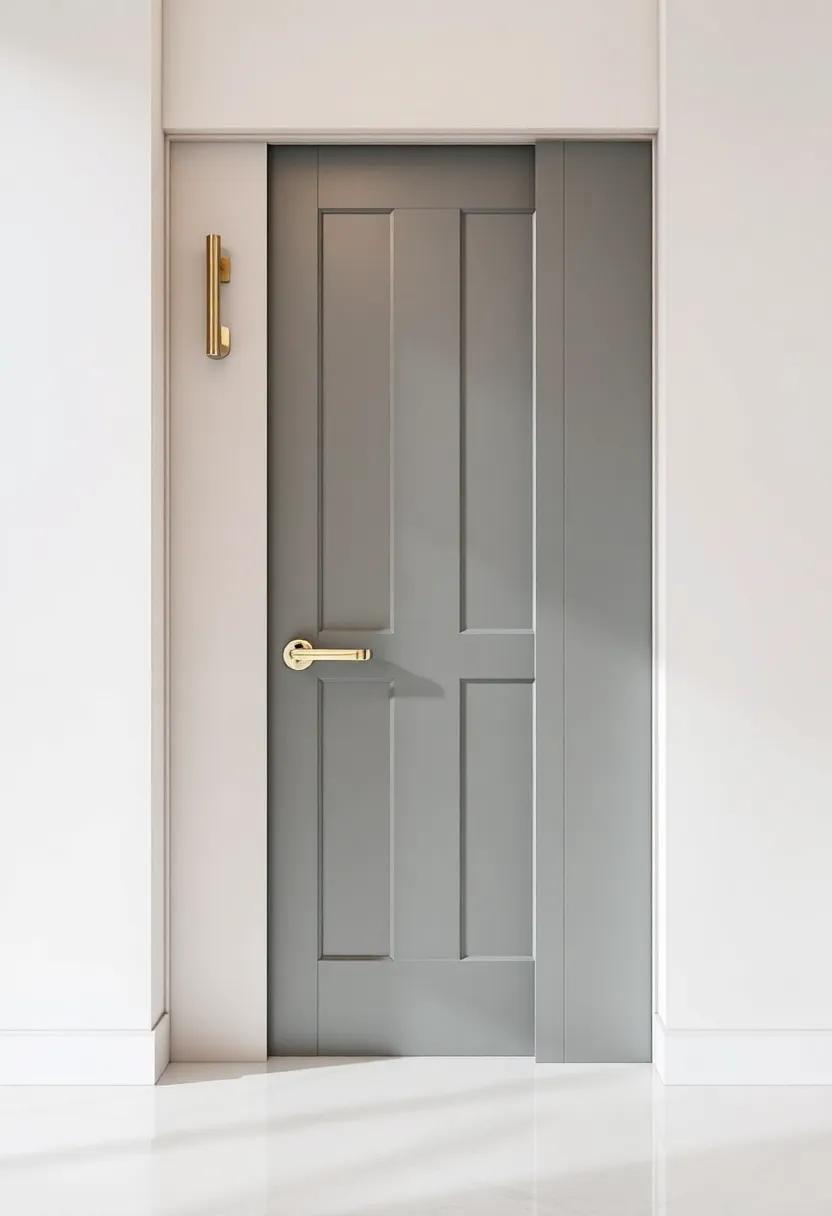
In the realm of Art Deco entryway designs,door handles and hinges serve not just as functional components but as captivating focal points that elevate the aesthetic of any home. With their bold lines and geometric patterns, these pieces embody the essence of the era, blending elegance with functionality. Look for polished brass, vintage-inspired chrome, or blackened steel finishes that highlight intricate detailing, giving each piece a unique character that can seamlessly integrate with various interior styles.
When selecting your signature hardware, consider the following elements that enhance the allure of your entryway:
- Geometric Patterns: Opt for handles and hinges that showcase angular designs or motifs that echo the Art Deco style.
- Contrasting Finishes: Mix materials to create visual interest, such as pairing matte black hinges with shiny gold handles.
- Custom Designs: Commission bespoke pieces that reflect your personal style while staying true to Art Deco influences.
| Material | Style | Feature |
|---|---|---|
| Polished Brass | Classic | Warm Shine |
| Artisan Bronze | Rustic | Handcrafted Detail |
| Chrome | Modern | Reflective Finish |
Cohesion through Style: Creating harmony with Art Deco Design Principles
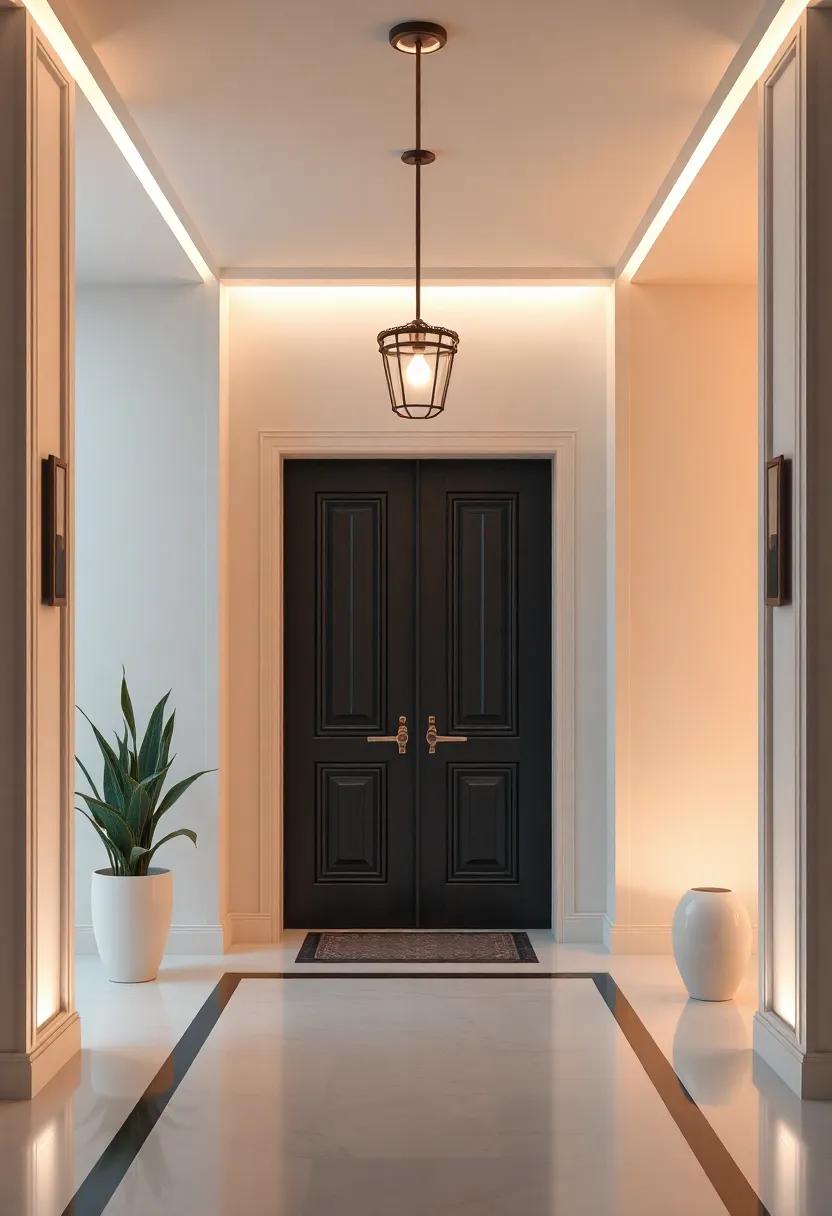
Art Deco serves as a stunning bridge between the opulence of the past and the sleekness of modern design. When applied to entryway designs, this style is marked by geometric shapes, bold colors, and luxurious materials that work together to create a welcoming yet sophisticated atmosphere.The use of streamlined forms and linear accents can transform an ordinary entrance into a statement piece that reflects elegance and a sense of grandeur. To embrace the Art Deco aesthetic, consider incorporating elements such as:
- Mirrored surfaces for a touch of glamour
- Intricate metalwork in door handles and fixtures
- Rich textiles like velvet or brocade for added texture
The cohesive nature of Art Deco design creates a harmonious flow as you move through the entryway into the rest of the home.Utilizing a balanced color palette inspired by jewel tones and metallics not only enhances the aesthetic but also establishes a warm welcome. Additionally, architectural features such as stylized arches, symmetrical patterns, and ornate moldings can draw the eye and make a lasting impression. The thoughtful blend of these elements leads to an environment that feels both curated and lived-in,perfect for making guests feel right at home.
Personalizing Your Space: Infusing Individuality in an Art Deco Entryway
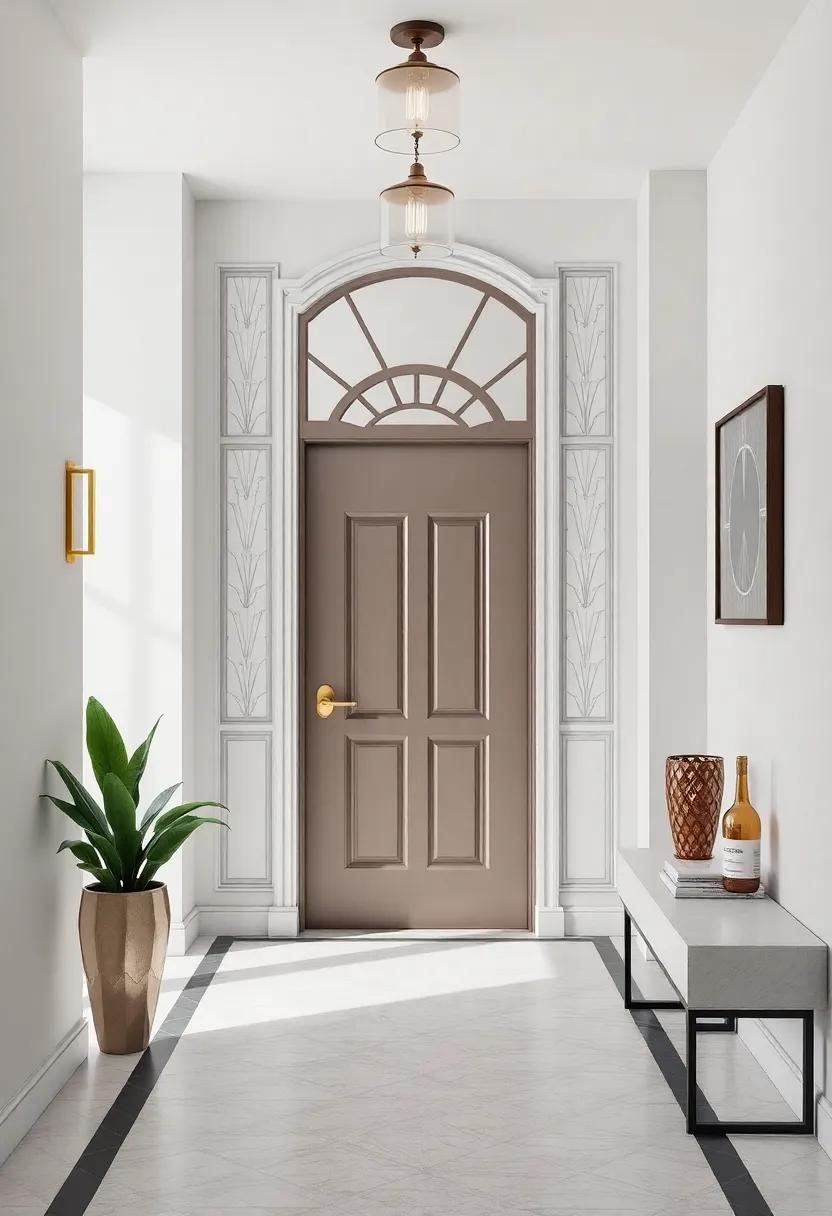
Transforming an art Deco entryway into a distinctly personal space involves a careful blend of classic elegance and individual flair. Start by paying attention to the color palette; consider deep hues like emerald greens or royal blues, paired with bold metallics such as gold or brass. These can serve as a backdrop for personal touches.Incorporate unique decor items that showcase your personality—such as a vintage mirror with an ornately framed silhouette, or a statement console table adorned with family photos or treasured souvenirs. experience the tactile allure of rich materials; think plush rugs, sleek marble surfaces, and leather accents that invite warmth and comfort.
Incorporating distinctive artistic elements can further enhance the character of your space. Choose artworks that resonate with you, be it an abstract painting or a sculpture that sparks conversation. Adding plants can also breathe life into the design; opt for stylish planters that complement the Art Deco aesthetic. Moreover, playful lighting fixtures, like geometric chandeliers, can create striking focal points while enhancing the overall ambience. To keep the space cohesive yet reflective of your individuality, create a harmonious rhythm using repeating shapes and patterns found in furniture and decorations, ensuring each piece contributes to a sense of sophisticated unity.
The Influence of Art Deco on Contemporary Entryway Trends

the enduring appeal of Art Deco, with its luxurious materials and geometric patterns, has left an indelible mark on contemporary entryway designs. today’s architects and interior designers are increasingly embracing this style to create spaces that exude sophistication and glamour. By integrating bold shapes, rich colors, and innovative lighting, contemporary entryways are channeling the spirit of the Jazz Age while adding modern sensibilities. The revival of luxurious details such as mirrored surfaces, metallic finishes, and vibrant color palettes has allowed homeowners to infuse their spaces with a sense of history and elegance that feels both timeless and fresh.
Many contemporary designs draw inspiration from classic art Deco characteristics to achieve a stunning entrance that makes a lasting impression. Here are some elements that are redefining modern entryways:
- Geometric Patterns: Bold, angular designs that create visual interest.
- Color Combinations: Deep blues and golds enhance the richness of the space.
- Lighting Fixtures: Statement chandeliers or sconces with an Art Deco flair.
- Materials: Incorporation of glass, metal, and exotic woods for a luxurious effect.
As we explore the intersection of past and present,one can see how specific features are utilized to elevate the entryway’s aesthetic.Below is a table highlighting popular elements adopted from Art Deco that are now prevalent in modern entryways:
| Element | Modern Interpretation |
|---|---|
| Curved Lines | Soft, fluid shapes in furniture and architecture. |
| Symmetry | Balanced layouts for visual harmony. |
| Ornamental Details | Intricate moldings and trim for added elegance. |
| Architectural Features | Grand doorways and high ceilings to enhance spaciousness. |
Creating Atmosphere with Scent and sound in Your Elegantly Designed Entryway

Enhancing the ambiance of your entryway is an art in itself. By integrating scent and sound, you can transform this pivotal space into a sensory delight. Imagine stepping into an Art Deco entryway, greeted by the rich aroma of subtly infused essential oils, such as jasmine or citrus, that evoke both elegance and warmth. Complement this with gentle background music—perhaps a curated playlist of jazz or classical melodies—that resonates with the historical essence of the art Deco movement. This harmonious combination can make every arrival and departure feel like a grand event.
To achieve the perfect sensory experience, consider the following elements:
- Accent Lighting: Utilize sconces or chandeliers that not only illuminate but also cast enchanting shadows, enhancing the sound experience.
- Aromatherapy Diffusers: Select elegant diffusers that align with your decor, releasing a consistent, soothing fragrance.
- Soundscapes: Invest in high-quality speakers discreetly integrated into the space, allowing the music to envelop the entryway without overwhelming it.
| Scent | Sound |
|---|---|
| Jasmine | Soft Jazz |
| Citrus | Classical Melodies |
| Lavender | Nature Sounds |
The Conclusion
As we close the door on our exploration of Art Deco entryway designs, we hope this journey has inspired you to embrace the elegance and sophistication that this timeless style offers. From the bold geometric patterns to the sumptuous materials, Art Deco captures a unique blend of glamour and functionality that transforms the ordinary into the extraordinary. Whether you’re looking to infuse a touch of vintage charm into your home or seeking to create a striking first impression for your guests, these designs hold a wealth of possibilities.
Ultimately, your entryway is more than just a passage; it’s the introduction to your personal sanctuary, a space where stories begin and memories are made. So why not step into elegance? Allow the allure of Art Deco to guide your choices,creating an inviting threshold that reflects not only style but also your individuality. Thank you for joining us on this architectural journey, and may your entryway become a doorway to inspiration.
As an Amazon Associate I earn from qualifying purchases.
